Other Instruments
Bowed Saw (Musical Saw)
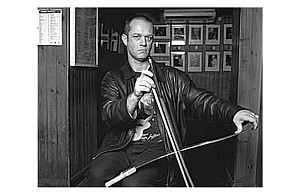
- November (The Black Rider, 1993)
- Flash Pan Hunter (The Black Rider, 1993)
- David Coulter, pictured above (The Black Rider theatre play, 2004)
The musical saw was very popular in the beginning of the 20th century. The fact that a saw can "sing" was discovered both in Europe and in the U.S. at about the same time. The musical saw reached its heyday in vaudeville, and died with it around world war II. Even though any carpenter's saw plays, there were many saws manufactured especially for playing music throughout history: The player can change the key by the way one bends the saw and the position of the bow. When one bows the saw up and plays on the wider end near the handle, one gets lower notes. On the upper end of the saw, the notes are higher. The bowed saw sounds a bit like the Theremin, only the saw has a more organic quality.
Bullhorn
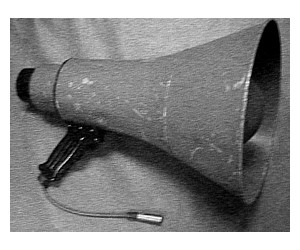
- Vocals on: Franks Wild Years, The Black Rider, Mule Variations
Tom Waits (1987): "When I finally discovered what a bullhorn can do to your whole sound, it was a big moment for me. I'd never sung through a bullhorn. I'd tried to get that effect in other ways. I tried cupping my hands, singing into tin cans, using those 7-dollar harmonica microphones, singing into pipes and there it was. A battery-operated bullhorn. Available at Radio Shack for $29.95." (Source: "From the set of Ironweed, Tom Waits talks with Rip Rense" New York Post: Rip Rense. Early 1987)
Tom Waits (1987): "Little opera line, there (Blow Wind Blow). Got a little carnival thing in it. Glockenspiel, pump organ. Used the bullhorn on it." (Source: "From the set of Ironweed, Tom Waits talks with Rip Rense" New York Post: Rip Rense. Early 1987)
Mark Rowland (1987): It's true you sang several of the new tunes through a police bullhorn? TW: "I've tried to simulate that sound in a variety of ways - singing into trumpet mutes, jars, my hands, pipes, different environments. But the bullhorn put me in the driver's seat. There's so much you can do to manipulate the image, so much technology at your beck and call. But still you gotta make choices. A lot of this stuff is 24-track; I finally allowed that and joined the twentieth century, at least in that regard." (Source: "Tom Waits is flying upside down (on purpose)" Musician: Mark Rowland. October, 1987)
Mark Rowland (1987): "The current apple of his musical arsenal, for instance, is a police bullhorn, through which Waits fashioned many of the vocals you hear on Frank's Wild Years. Not just any horn, of course, but an MP5 Fanon transistorized megaphone (with public address loudspeaker). "It's made in Taiwan," Waits adds proudly." (Source: "Tom Waits is flying upside down (on purpose)" Sidebar. Musician: Mark Rowland. October, 1987)
Bill Forman (1987): "Another innovation on Frank's Wild Years is the prevalence of the bullhorn, which Waits sings through on at least four cuts. TW: "Well, I tried to obtain that same sound in other ways, by using broken microphones, singing into tin cans, cupping my hands around the microphone, putting the vocal through an Auratone speaker, which is like a car radio speaker, and then miking that. Practically even considered at one point making a record and then broadcasting the record through like a radio station and then having it come out of the car and then mike the car ... and then it just became too complicated, you know? So a bullhorn seemed to be the answer to it all."(Source: "Better Waits Than Ever" Music & Sound Output: Bill Forman. Vol. 7, No. 11. October, 1987)
Tom Waits (1996): "Around 1982, my wife Kathleen encouraged me to try singing through a police bullhorn to make my voice stand out in relief when incorporated with instruments of the same color. Of course, it's possible to do the same thing with an equalizer, but nothing beats the drama of a bullhorn. My engineer Biff Dawes purchased me my first, and it was love at first sight -- I never record or tour without it. I also try to buy a new one every year, because they continue to "improve" upon them. I find the older 80s models (the Falon is available at Radio Shack for about $29.95) superior; they're warmer to the ear. Also interesting to explore are the ones made for children, that can change a voice from monster to spaceman to robot. I found humming through them can give you a sound much like Blue Cheer's guitar sound on "Summertime Blues." In addition to these I also own a 1944 electric megaphone, issued by the Navy Bureau of Ships and made by the Guided Radio Corps of New York. The bell is 24 inches in diameter and it's battleship gray. If you want to feel "Federal", it's the one for you." (Source: "Sound Hound": Foreword by Tom Waits to Bart Hopkin's book/ CD: "Gravikords Whirlies & Pyrophones - Experimental Musical Instruments." Publisher: Ellipsis Arts. October, 1996)
Paul Tingen (2000): "Hitting a hotel room and recording this into a boombox, as Waits did, is clearly a low-fi approach, just as recording a group of musicians outside with an old shotgun mic is. Waits also sang a few things through an amplified megaphone on Chocolate Jesus, and through a two-foot long PVC pipe on Get Behind The Mule." (Source: "California Screamin'" Audiomedia magazine (UK), by Paul Tingen. February, 2000)
Chair
- Shore Leave (Swordfishtrombones, 1983)
TW (1999): "Everything is a potential instrument, it depends on how you use it. I remember I was doing Swordfishtrombones and somebody took a stool -- a metal stool -- and started dragging it across the studio floor to move it out of the way. And I said, "That's really thrilling. Do that again and abundantly and carefully and repeatedly, please." It sounded like bus brakes on a big city bus. So I like things that fall outside of the spectrum of what we consider traditional instruments and acceptable sound. I love all that." (Source: "Tom Waits '99, Coverstory ATN Addicted to Noise: Gil Kaufman and Michael Goldberg. April, 1999)
TW (2002): "I like sounds that are not conventionally considered music. We were in the studio doing 'Swordfishtrombones' and we were already trying to find our own musical galaxy. While I was there, someone was fixing a mic, and dragging a chair across the floor and it made the most beautiful sound like, [in a high pitch] "eeeeeehhh". And I was thinking, jeez, that's as musical as anything I heard all day, and I'm here to make music. So maybe I should be paying more attention to the things that are outside what we think we're here to do." (Source: "Tom Waits" SOMA magazine (USA) by Mikel Jollett. July, 2002)
Cristal Baschet (Crystal Organ, Crystal Baschet)
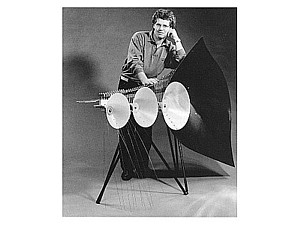
- Thomas Bloch, as pictured above (The Black Rider theatre play, 2004)
The principle of a glass bow and a metal rod fixed to a heavy metal block, which could be seen in laboratories during the 18th century but had never been used before to make a musical instrument, was revived in 1952 by Bernard and Fran�ois Baschetwho also invented the inflatable guitar and an educational instrumentarium. The Cristal Baschet (not Cristal Bachet, but sometimes called Crystal Organ and in English, Crystal Baschet) is composed of 54 chromatically tuned glass rods, rubbed with wet fingers. So, it is close to the Glassharmonica. But in the Cristal Baschet, the vibration of the glass is passed on to the heavy block of metal by a metal stem whose variable length determines the frequency (the note). Amplification is obtained by fiberglass cones fixed on wood and by a tall cut out metal part, in the shape of a flame. "Whiskers", placed under the instrument, to the right, increase the sound power of high-pitched sounds.
Glass Harmonica (Glass Armonica)
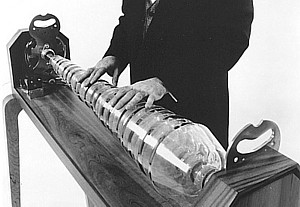
- Rainbirds (Swordfishtrombones - Francis Thumm, 1983)
- Thomas Bloch (The Black Rider theatre play, 2004)
The glass armonica was invented by Benjamin Franklin in 1761. It consists of glass bowls tuned by size, mounted one inside each other with cork on a metal spindle. The glasses are made to spin with a flywheel attached to a foot treadle. Moistened fingers rub the exposed rims of the glasses to produce one of the most beautiful sounds ever created by man. Jefferson, Mozart, Beethoven, and Mesmer are only a few of the famous men associated with the armonica.
TW (1983): "It's myself at the piano (Rainbirds) and Greg Cohen on acoustic bass. It's a real pleasure to work with him. We have a mutual intuition and it's really good to hear him again. Francis Thumm helped me with glass harmonica introduction."(Source: "A Conversation with Tom Waits (Swordfishtrombones)" Island Records music industry white label 12" promo. Date: September, 1983)
Further reading: Glass armonica 1, Glass armonica 2, Glass armonica 3
Indonesian Seed Pod
- Everything You Can Think (Alice, 2002)
- Kommeniezuspadt (Alice, 2002)
- Misery Is The River Of The World (Blood Money, 2002)
- God's Away On Business (Blood Money, 2002)
JB (2002): "On the albums (Alice/ Blood Money), the self-described "sound hound" used some odd instruments, including a Stroh violin (a violin with a horn appendage), a calliope (found by his brother-in-law on a flatbed truck in Iowa) and percussive Indonesian seed pods (with seeds the size of grapefruits)." (Source: "Tom Waits peers through the looking glass on two new discs" Star Tribune (USA) by Jon Bream. February/ March. Published: May 5, 2002)
JP (2002): "The music drags hymns and parlor songs, blues and ballads into a sonic menagerie that, on the new albums, includes Swiss hand bells, calliope and a four-foot-long Indonesian seed pod, which is "as wide as a Bible," he said, and has "seeds as big as CD's." (Source: "Tom Waits: A Poet of Outcasts Who's Come Inside" New York Times (USA) by Jon Pareles. Published: May 5, 2002)
JS (2002): "Recordings of both scores were made only recently, but ''Alice'' - haunting, jazz-tinged, exotic - came first, performed in 1992. Instrumentation includes Stroh violin (a violin affixed with a brass horn), cello, viola, piano, upright bass, clarinet, marimba, saxophone, trumpet, and drums... On ''Blood Money,'' which debuted in 2000, Waits lost the string section but added a 1929 pneumatic calliope - an old circus instrument with 57 whistles - harmonica, and a dried boomerang seed pod from a rare tree that grows only in Indonesia." (Source: "With morbidity on his mind, Tom Waits makes a double play" The Boston Globe (USA) by Jim Sullivan. Published: May 5, 2002)
GK (2002): To give "Alice" and "Blood Money" their distinctive characters, Waits introduced a few more oddities to his sound-making arsenal: a stroh violin (a violin crossed with a brass horn), a pod (a four-foot seed pod from Indonesia, used as a percussion instrument) and a 1929-vintage pneumatic calliope." (Source: "2 albums at once? That's Waits' way Chicago Tribune (USA) by Greg Kot. Published: May 5, 2002)
DC (2002): "Like all Waits' efforts since Swordfishtrombones ('83), it's stylistically varied, with an overall production "patina"--in this case a dry, raspy shibui (the Japanese word for dilapidation) sound personified by the pod (a 4-foot-long Indonesian bean shaker), marimbas and a 57-whistle pneumatic calliope that reverberated for five miles in the Sonoma shack where the CDs were recorded." (Source: "Blood on the looking glass" Chico News and Review (USA) by Dan Cohen. Published: May 7, 2002)
CW (2002): "Blood Money lives mostly at the harsher end of the Waits emotional scale. From Wilson's adaptation of Georg Buchner's Woyzeck, which comes to New York next fall, it's the tale of a soldier who goes insane after he is played false by the army and his girlfriend. It screeches and roars through rhythmic arrangements for pump organ, sax, bells, bass, drums and a four-foot-long seed pod from the Indonesian Botang tree that Waits's musicians shake like a baby rattle from hell. And its message is brutally clear: Misery is the River of the World ("everybody row!"), Everything Goes to Hell, "life's a mistake all day long . . . you'll never get out alive." (Source: "A double shot of Waits Globe and Mail (Canada) by Carl Wilson. Published: May 7, 2002)
PG (2002): To add to the songs' (Alice/ Blood Money) other-wordliness, Waits uses the Mellotron (an early synthesiser), which had its heyday in the 1970s in bands such as the Moody Blues, and his latest "found objects", such as a 1929 pneumatic calliope (an old circus instrument with 57 whistles) and a dried boomerang seed pod from a rare Indonesian tree." (Source: "Lying in Waits" The Age (Australia) by Patrick Donovan. Published: May 10, 2002)
Q (2002): And where does one find a boomerang seedpod? TW: "On butang trees in Indonesia. The pods are four feet long and they twist like pasta when they dry. There are like 12 massive seeds inside, each bigger than a hockey puck. I love the sound of it, a big, mean, low rattling." (Source: "I hope more people misunderstand me" USA Today (USA), by Edna Gundersen. Published: June 17, 2002)
Kid's Toys/ Instruments
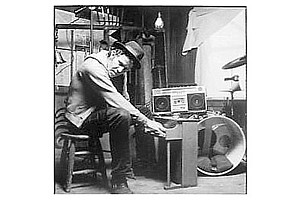
- Toy piano (Woyzeck theatre play, 2000)
- Calliope - toy piano (Blood Money, 2002)
- Bent Clausen - toy piano (The Black Rider theatre play, 2004)
TW (1985): "It's interesting to write on instruments you don't understand. You know, I pick up a saxophone and bang on a drum... or eh y'know... eh trombone. Anything that I'm unfamiliar with, that is always eh... it's always good for your process. Y'know?" Q: You wind up with different ideas for melodies? TW: "Yeah, yeah. And kid's toys, you pick up the little instruments that kids have y'know? Bang on those... and it's... The piano always makes me feel like I'm..." (Source: "CBC Nightlines Interview" Nightlines on CBC Stereo (Canada). Michael Tearson. New York, late 1985)
TW (1992): "Hey, you know, children's instruments - really, the stuff that's available for children - some of it sounds better than the grown up stuff. I bought a drum set for $49.00 and it was unbelievable the sound that we got from it. It's a toy drum set, kick drum, 2 toms, temple block, sizzle cymbal - and it's the tits. I thought it was just top notch. I would have paid more for it but they wouldn't take it. They only wanted $49.00. I said let me give you 100 for this thing just so I feel better." (Source: "KCRW-FM: Evening becomes Eclectic" KCRW-FM radio. Santa Monica. October 9, 1992)
Metal Aunglongs (Angklungs)
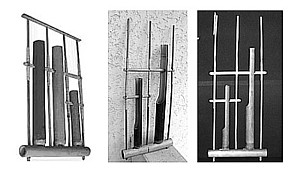
- Shore Leave (Swordfishtrombones - Francis Thumm, 1983)
- Black Box theme (The Black Rider, 1993)
Should be spelled as "Angklungs". Angklung is a style of gamelan found primarily in Bali, Indonesia. It is also the name of a bamboo musical instrument from which the ensemble gets its name. The musical instrument called angklung is made out of two bamboo tubes attached to a bamboo frame. The tubes are carved so that they have a resonant pitch when struck. The two tubes are tuned to octaves. The base of the frame is held with one hand while the other hand shakes the instrument rapidly. This causes a rapidly repeating note to sound. Each person in an ensemble will play just one note. Traditionally, large numbers of them are shaken for ceremonial dances. They can also be played by a group of musicians, each of whom has one instrument of differing pitch in each hand. The entire group performs a single melody in much the same way as a handbell choir, with each performer shaking an angklung at the appropriate time in the melody. Carl Orff included unpitched angklung in his "Catulli Carmina" and "Weihnachtsspiel," and scored "Prometheus" for two angklung pitched in G-flat and B-flat. In the early 20th century, J.C. Deagan developed an American version, called Organ Chimes or Aluminum Chimes, constructed from metal (essentially a metal angklung). When mounted on a rack, which allowed one or two people to perform solo pieces, Deagan's Organ Chimes became a popular novelty instrument for vaudeville and radio shows.
TW (1983): "I tried to add some musical sound effects (Shore Leave) with the assistance of a low trombone to give a feeling of a bus going by, and metal aunglongs the sound of tin cans in the wind, or rice on the bass drum to give a feeling of the waves hitting the shore. Just to capture the mood more than anything of a marching marine or whatever walking down the wet street in Hong Kong and missing his wife back home." (Source: "A Conversation with Tom Waits (Swordfishtrombones)" Island Records music industry white label 12" promo. Date: September, 1983)
TW (1983): "Some of the stuff I think is a bit of a departure for me. Ehm... the instrumentation is all different, and no saxophones. I used the banjo, accordion, bass-marimba, ehm metal aunglongs ehm you know African squeeze drum, a calliope, a harmonium. Eh, so some of the stuff is a little more exotic." (Source: "Saturday Live Interview With Tom Waits Source: BBC Radio One (UK) by Richard Skinner. October 22, 1983)
TW (1983): "I've always been afraid of percussion for some reason. I was afraid of things sounding like a train wreck, like Buddy Rich having a seizure. I've made some strides; the bass marimbas, the boobams, metal long longs, African talking drums and so on." (Source: "The Beat Goes On". Rock Bill magazine (USA). October 1983, by Kid Millions)
RR: "Waits had gone from a sax-bass-guitar-drums configuration to using everything from Balinese metal aunglongs, pump organs and banjos to bass boo-bams and bagpipes." (Source: "Waits In Wonderland" Image magazine/ San Francisco Examiner (USA), by Rip Rense. Date: December 13, 1992)
Microphones/ Recorders, Sampling/ Looping
MR (1987): "Not too surprisingly. Waits prefers "mostly tube stuff' to digital equipment. Microphones of choice include a Ribbon ("Dave Garroway") and RCA high-impedance mikes; Waits usually sings through a Shure Green Bullet (used mostly by harmonica players). Also an Altec 21D vocal mike- "because Sinatra used it." On guitar, Waits likes his Gretsch New Yorker "with old strings" played through an old Fender tweed basement amp. When recording, he says he uses a lot of heavy compression with room sound; to do that he'll sometimes push the track into the room through Auratone speakers, and then mike that. It's not his only technique, "but I don't want to give away all my secrets." (Source: "Tom Waits is flying upside down (on purpose)" Sidebar. Musician: Mark Rowland. October, 1987)
BF (1987): "Likening the sterile confines of the studio to an emergency ward, Waits seems intent on performing some very unorthodox operations. Take "Innocent When You Dream," which appears in two disguises on Frank's Wild Years. The "barroom version" puts across the melancholy melody (reminiscent of a mournful Irish drinking song) by way of pump organ, upright bass, violin and piano. A second version closes out side two, stripped down and scratched up enough to inspire visions of an ancient Victrola. Says Waits: "The '78 version' of that was originally recorded at home on a little cassette player ["the Tascam 244, the one with the clamshell holster"]. I sang into a seven-dollar microphone and saved the tape. Then I transferred that to 24-track and overdubbed Larry Taylor on upright, and then we mastered that. Texture is real important to me; it's like attaining grain or putting it a little out of focus. I don't like cleanliness. I like surface noise. It kind of becomes the glue of what you're doing sometimes."(Source: "Better Waits Than Ever" Music & Sound Output: Bill Forman. Vol. 7, No. 11. October, 1987)
BF (1987): "But don't expect '78 versions' of any of these new songs, for Waits' Tascarn four-track is gone, clamshell holster and all. "Stolen in New York," he shakes his head, suppressing a smile. "That's why I left - they beat me up." (Source: "Better Waits Than Ever" Music & Sound Output: Bill Forman. Vol. 7, No. 11. October, 1987)
TW (1985): "Nowadays, if you want a certain sound you don't have to get it now, you can get it later. When you're mixing, electronically. I wanted to get it now, so I felt I cooked it and I ate it. You can establish percussion sounds later electronically. But I ended up banging on things so I felt that it really responded. If I couldn't get the right sound out of the drum set we'd get a chest of drawers in the bathroom and hit it real hard with a two-by-four. Things like that. That's on "Singapore". Those little things made me feel more involved that sampling on a synthesizer." (Source: "Tom Waits For No Man" Spin Magazine: Glenn O'Brien. November, 1985)
MR (1994): "It is nearing midnight at the Sound Factory. Waits would like to add a guitar track to the song "Crossroads". He likes the feel of the hallway outside the studio so Kloster and Dawes set him up there. Waits doesn't have quite the sound he wants from the arrangement, so Dawes asks if he would like to try something called the transient distortion from an overloaded condenser microphone effect? Translated, this means Waits will play his guitar in the hallway on an old Fender amp recorded through the tiny mikes in a battered 20-year-old boom box." (Source: "The music of chance" Spin Magazine: Mark Richard. June, 1994)
Q (1999): The beginning of "Big In Japan" is one of the more startling sounds you've ever put on record.
TW: "I was in Mexico in a hotel, and I only had this little tape recorder. I turned it on, and I started screaming and banging on this chest of drawers really hard, till it was kindling, trying to make a full sound like a band. And I saved that. That was years ago. I had it on a cassette, and used to listen to it and laugh. It sounded like some guy alone in a room, which it was, trying his hardest to sound like a big, loud band. So we stuck that in the front." (Source: "A Q&A about Mule Variations" MSO: Rip Rense. April, 1999)
Q (1999): "Big in Japan" is the first song on Mule Variations and there's some strange sounds the minute you put the CD on. Is that a sample of your own vocal percussion? What's happening there? TW: "It's just a contest I had with myself in a hotel room. I wanted to see if I could sound like a band all by myself, without any instruments. So I stood banging on the chest of drawers and the wall and headboard, just trying to, you know, get that sound -- like that full band sound. That's what I wound up with; looped it and sampled it. Or sampled it and looped it or whatever they call it. " (Source: "Mule Conversations" Austin Chronicle: Jody Denberg. February/ April, 1999)
TW (1999): "I just started playing around with samples, which is kind of a new world to me. Brought a guy in, DJ Mark "The III Media" Reitman. There's a gospel thing on 'Eyeball Kid', and some Balinese samples." (Source: "Mojo interview with Tom Waits" Mojo magazine: Barney Hoskyns. April, 1999)
TW (1999): "Yeah, they're good guys (Primus) and fearless adventurers. They love adventure. They will play anything, they will do anything. They like the unusual and the bizarre, they're game, they got zeal. We did another song with them called "2:19." It's about a train. We sawed a log in half and took the voomfa, voomfa sound and looped it. So we had voomfa, voomfa, which sounded like a train, like a steam-driven train. That song came out great but it didn't make the record."(Source: "Tom Waits '99, Coverstory ATN Addicted to Noise: Gil Kaufman and Michael Goldberg. April, 1999)
PT (2000): "The track Black Market Baby was filled with a Pro Tools loop of record needle noise of a 78rpm record, and guitar distortion pedals were used as effect units in the mix. King also had an old Sony reel-to-reel which was used as a mic pre-amp. mic pre-amps were overdriven and sometimes plugged into each other, and old crystal mics were used." (Source: "California Screamin'" Audiomedia magazine (UK), by Paul Tingen. February, 2000)
JK (2000). "I think Tom definitely feels that analogue has a better overall sound, although I don't think he looks down on digital. For this album he wanted to experiment with playing loops, and the possibility of changing the arrangements on the songs. I suspect he'd been hearing from friends and associates how powerful Pro Tools was and wanted to check it out. But the overall sound of the album is analogue. Pro Tools is just a component. I did some loops, such as Tom's metal dressing bashing on Big In Japan, the Optigon keyboard sound on Lowside Of The Road, and the vinyl needle sound on Black Market Baby. On Filipino Box Spring Hog I actually changed the arrangement of some of the overdubs, although the drum and vocal performance are true to the take. In the latter track there were also some small voices that Tom had recorded into a small toy sampler for kids, and that I sampled in Pro Tools, just like the turntable elements. All this was manipulated in Pro Tools and then laid back to tape." (Source: "California Screamin'" Audiomedia magazine (UK), by Paul Tingen. February, 2000)
Julian McBrowne (2005): "More recently, Tom Waits began tracking vocals using an expensive large-diaphragm condenser mic patched through a cheap boom box (which he refers to as his "Secret Weapon"), and then into a pricey tube mic preamp. It's not what you'd call a textbook signal path, but it has helped him achieve his signature sound." (Source: "Do the Wrong Thing". By Julian McBrowne. Electronic Musician, Aug 1, 2005)
Ondes Martenot
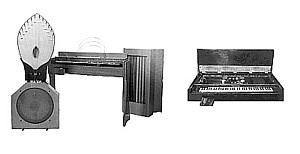
- Thomas Bloch (The Black Rider theatre play, 2004)
In 1928 the frenchman Maurice Martenot developed the Ondes Martenot whose circuitry was almost certainly based on that of the Theremin (the Onde uses sine and saw tooth wave sources) but whose playing technique was quite different. Like the theremin the Ondes Martenot is monophonic (playing one note at a time) and variations in pitch are obtained either on a keyboard with a range of 7 octaves or by a 'ribbon'. This ribbon has a ring into which the right index finger is inserted and notes are produced by sliding the finger ring to various contact points which produces a portamento effect between pitches much like a fretless violin fingerboard. However no sound is heard at all until a button known as the "touche" housed in a drawer is depressed with the left hand.
Photon Clarinet
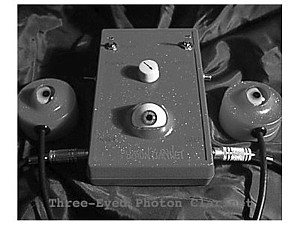
- Alice theatre play rehearsals, 1992 (not on record)
Photon Clarinets are played without touching. Waving a hand over the right-hand sensor steps the pitch through arbitrary notes, as in an alien keyboard; a hand over the left-hand sensor smoothly sweeps the notes, as in a theremin. Very high to very low range light-sensitive instrument. All models have a range control for setting the frequency of the "free" note that the unmodulated instrument returns to, a focus switch that phases the ends of the note envelopes, an internal speaker with on/off switch, power switch with blue LED pilot lamp, red envelope LED and gold-plated RCA line output. All operate on a single 9V battery, contain the same circuitry as well as sound and play the same.(Source: "Waits in Wonderland" Image: Rip Rense. December 13, 1992)
Tom Waits (1996): "Bart (Hopkin) has compiled a gathering of some of the best minds in the field (Gravikords Whirlies & Pyrophones), including Qubais Reed Ghazala, whose photon clarinet (I own one) sounds like a keyboard lobster dying on a campfire. It is only one in a series of wizardly deivces designed for the nonconformist. With the digital revolution wound up and rattling, the deconstructionists are combing the wreckage of our age. They are cannibalizing the marooned shuttle to send us on to a place that will sound like a roaring player piano left burning on the beach." (Source: "Sound Hound": Foreword by Tom Waits to Bart Hopkin's book/ CD: "Gravikords Whirlies & Pyrophones - Experimental Musical Instruments." Publisher: Ellipsis Arts. October, 1996)
Tom Waits (1998): "Up where we live there's a lot of people that build their own instruments and that's Harry Partch country up there where we are. He lived in Petaluma for a long time and there seems to be a little enclave of his niche - artists up there that build - instrument builders and sculptors and all that. There's a very interesting guy who lives in Ohio, his name is Q Reed Ghazala and he made something called the Photon Clarinet that is a box with a light sensitive patch on the top and the tone responds to the intensity of light so if you aim a flashlight at it it goes crazy and it sounds like you just threw a lobster on a campfire and then if you bring the lights down it goes kinda hoooooo augghh - down in here. He takes apart toys and puts them back together and they're never the same. There's a lot more conventional guys up there that do like stuff from a hardware store, you know." (Source: "KCRW-FM: Morning becomes Eclectic" KCRW-FM radio. Santa Monica. March 31, 1998)
Further reading: Reed Ghazala/ Photon clarinet 1, Reed Ghazala/ Photon clarinet 2
PVC Membrane Saxophone
- Gerd Bessler (Alice theatre play, 1992)
RR (1992): "Moments prior to this interview, Waits was packing his suitcases with socks, underwear - and experimental musical instruments called Wind Wands, photon clarinets, PVC Membrane saxophones, a Waterphone and something called a T-Rodimba... The "Alice" instruments, Waits excitedly points out, were built by "real pioneers" of music living in the Bay Area: Richard Waters (the Waterphone, a polytonal metal instrument filled with water), Tom Nunn (the T-Rodimba, a conglomeration of plywood and hardware with a violin pick-up), Darrel DeVore (Wind Wands, "which sound like Orville and Wilbur"), Bart Hopkins (PVC Membrane saxophones, which are too complex to explain succinctly) and Reed Ghazala (photon clarinets, which are played by beams of light bouncing off light-sensitive keys)." (Source: "Waits in Wonderland" Image: Rip Rense. December 13, 1992)
Theremin
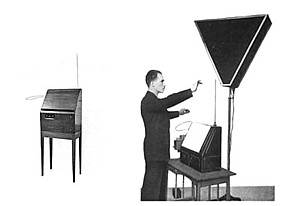
- Lydia Kavina (Alice theatre play, 1992)
The Theremin is one of the earliest electronic instruments, and is played without ever physically touching it. Outfitted with two antennas, a magnetic field surrounds the instrument, and when the hands of the player enter the field, changes in pitch and volume occur. The left side controls the volume, and the right controls the pitch. The instrument was invented and manufactured in the 1920's by Leon Theremin (Russian Physician Lev Sergeievich Termen, anglicized in Leon Theremin).
TW (2002): "The best part about it (1992 staging of Alice) was that we had a woman from Moscow who played the theremin who was the granddaughter of Leon Theremin, the man who invented the instrument," Waits recalls of the original production. "She was like a little Russian doll, and she was just amazing. You'd think Leon Theremin's granddaughter would have a rosewood or ebony theremin with inlaid mother of pearl, but hers looked like a hot plate. It was painted in a drab color with somebody's initials carved into it, and a car aerial protruding from the box. Inside, all the electrical connections and circuitry were attached with cut-up pieces of a beer can, folded over the wires. She was a true Russian, the musical equivalent of the good butcher who uses every part of the cow." (Source: "2 albums at once? That's Waits' way Chicago Tribune (USA) by Greg Kot. Published: May 5, 2002)
TW (2002): "We tried to find a theremin for Alice (the album), but we were unable to find anyone locally that was really accomplished. The woman that played in the original Alice orchestra we found was the granddaughter of Leon Theremin. She was really amazing. You would imagine someone like that would have some really sophisticated instrument, but she brought this thing that looked like a hotplate with a car aerial coming out of it. She opened it up, and inside, all the connections between the circuits were established with cut-up little pieces of beer can wrapped around the wires. All the paint was worn off, but when she played it, it was like Jascha Heifetz. They're doing experiments with the theremin now. The sound waves you experience when you play it have therapeutic value." (Source: "Tom Waits" The Onion online magazine (USA) by Keith Phipps. Volume 38, issue 20. Published: May 29, 2002)
TW (2002): "In the original orchestra for Alice, we used a theremin player, Lydia, the granddaughter of Leon Theremin. You figure someone like that would have this rosewood, ebony and mother-of-pearl theremin. Hers looked like a hotplate with chipped house paint and a car aerial coming up out of the corner. It was hilarious." (Source: "I hope more people misunderstand me" USA Today (USA), by Edna Gundersen. Published: June 17, 2002)
Further reading: Theremin 1, Theremin 2
Waterphone
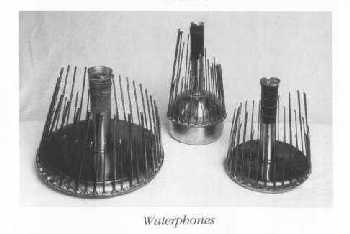
- Ali Husseini (Alice theatre play, 1992)
- Woyzeck theatre play, 2000
- Also featured on Moanin' Parade & Swarm Warnings (Gatmo, 2000)
Waterphones (invented by Richard A. Waters) are stainless steel and bronze monolithic, one-of-a-kind, acoustic, tonal-friction instruments that utilize water in the interior of their resonators to bend tones and create water echos. The rods can be played with superball mallets, by hand or with a bow. When the tonal rods are sounded some of the fundamental tones and/or harmonics are sympathetic to the bottom & top diaphragms. When the attitude of the Waterphone is changed from vertical to horizontal and all in between the water is being moved on and off the bottom diaphragm as the tones are being sounded. The water acts in 2 ways - (1) to bend tones via the weight of the water on the bottom diaphragm which lowers the tone when the Waterphone is in the vertical position and raises the tone when in the horizontal position and (2) creates acoustic, schiziosonic, modulations as in pre-echoes via the motion of the water and the relative speed of sound in water, air and metals.
RR (1992): "Moments prior to this interview, Waits was packing his suitcases with socks, underwear - and experimental musical instruments called Wind Wands, photon clarinets, PVC Membrane saxophones, a Waterphone and something called a T-Rodimba... The "Alice" instruments, Waits excitedly points out, were built by "real pioneers" of music living in the Bay Area: Richard Waters (the Waterphone, a polytonal metal instrument filled with water), Tom Nunn (the T-Rodimba, a conglomeration of plywood and hardware with a violin pick-up), Darrel DeVore (Wind Wands, "which sound like Orville and Wilbur"), Bart Hopkins (PVC Membrane saxophones, which are too complex to explain succinctly) and Reed Ghazala (photon clarinets, which are played by beams of light bouncing off light-sensitive keys)." (Source: "Waits in Wonderland" Image: Rip Rense. December 13, 1992)
TW (1994): "Your hands are like dogs, going to the same places they've been. You have to be careful when playing is no longer in the mind but in the fingers, going to happy places. You have to break them of their habits or you don't explore, you only play what is confident and pleasing. I'm learning to break those habits by playing instruments I know absolutely nothing about, like a bassoon or a waterphone." (Source: "The music of chance" Spin Magazine: Mark Richard. June, 1994)
MR (1994): "The waterphone is from Waits' collection of exotic instruments. It looks like two pizza pans welded face together with a length of rope-wrapped muffler pipe fitted to the center. Varying lengths of steel rods are staggered around the edges. When water is poured down the muffler pipe into the pizza pans you rop the rods with a mullet or draw a bow across them to achieve deep-sea, science-fiction-movie sounds." (Source: "The music of chance" Spin Magazine: Mark Richard. June, 1994)
Further reading: Waterphones 1, Waterphones 2

